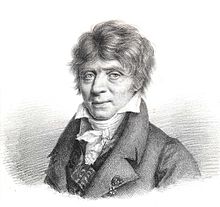Gaspard de Prony
Gaspard Clair François Marie Riche de Prony (born July 22, 1755 in Chamelet (Rhône), † July 29, 1839 in Asnières-sur-Seine ) was a French applied mathematician , hydraulic engineer and hydraulic engineer .
Life
De Prony (the family was originally called Riche) studied at the École Nationale des Ponts et Chaussées from 1776 to 1779 . In 1780 he worked under Jean-Rodolphe Perronet on the construction of the Pont de Neuilly and helped this in 1785 with the repair of the port of Dunkirk . In the same year he accompanied Perronet to England to determine the exact distance between the Greenwich observatory and that of Paris. In 1783 he returned as an engineer to the École Nationale des Ponts et Chaussées in Paris. In the same year he published his first essay on the statics of arches, which brought him to the attention of Gaspard Monge . In 1787 Prony was appointed inspector at the École des Ponts et Chaussées and was involved in the construction of the Pont de la Concorde (then Louis XVI Bridge ) in Paris, whereupon he became chief engineer at the École des Ponts et Chaussées in 1791. In 1792 he began a long-term project with Adrien Marie Legendre , Lazare Carnot and other mathematicians to create trigonometric and logarithmic tables. This was made necessary by the introduction of the new metric system after the French Revolution , which resulted in a standardization of measurements. Prony became a member of the commission for the introduction of the metric system. The work, which involved around 80 assistants, lasted until 1801, and the tables were (partially) published in 1809.

In 1794 he became a mathematics professor at the newly founded École polytechnique (which was headed by Lazare Carnot and Monge), in 1798 he went back as director of the École Nationale des Ponts et Chaussées. Mainly because Prony wanted to take this position, he also refused to participate in the Egyptian expedition of Napoleon Bonaparte , which angered them. But there were no worse consequences because de Prony's wife was friends with Josephine Bonaparte . He also became a member of the Bureau des Longitudes . With the defeat of Napoleon, he lost his professorship at the École Polytechnique in 1816, but shortly thereafter became one of the examiners there again. In later years he opposed what he believed to be the theoretical mathematical orientation of the teaching under Augustin Louis Cauchy , but was unsuccessful.
In approximation theory he considered the issue in 1795 a function (with constant , ) from their function values at different points to win and hit quite a way to do this before. Originally it dealt with a problem of physical chemistry, but the method was later used elsewhere, for example in signal processing for radar and in super-resolution in microscopy. The earth pressure theory also enriched Prony. To determine the active earth pressure on retaining walls with a vertical wall line, he found a simple relationship between the slope angle and the slip angle, which Karl-Eugen Kurrer called Prony's theorem.
Several volumes of Prony's lectures at the École Polytechnique and École des Ponts et Chaussées were published and were widely used textbooks for French engineers at the time. On November 20, 1795 he became a member of the Académie des Sciences in Paris. In 1818 he was admitted to the Royal Society as a Foreign Member .
In 1805 he was elected a foreign member of the Göttingen Academy of Sciences . Since 1807 he was a foreign member of the Bavarian Academy of Sciences and since 1820 a member of the Royal Society of Edinburgh .
His name is immortalized on the Eiffel Tower, see: The 72 names on the Eiffel Tower .
Fonts
- Architecture hydraulique, 2 volumes, Paris, 1790, 1796
- Lecons de mécanique analytique, Paris 1810
literature
- Margaret Bradley Prony the bridge-builder: the life and times of Gaspard de Prony, educator and scientist , Centaurus, vol. 37, 1994, 230-268
See also
- Pronyscher Zaum - brake dynamometer for measuring the torque of machines, introduced by de Prony in 1821.
Web links
- John J. O'Connor, Edmund F. Robertson : Gaspard de Prony. In: MacTutor History of Mathematics archive .
- Article by / about Riche Prony in the Polytechnic Journal
- Entry for Prony, Gaspard Clair Francois Marie Riche de (1755-1839) in the Archives of the Royal Society , London
Individual evidence
- ↑ Stephen Timoshenko History of Strength of Materials
- ↑ Timoshenko, loc. cit.
- ↑ Tomas Sauer, Prony's method: an old trick for new problems , Mathematical Snapshots, Oberwolfach 2018
- ^ Karl-Eugen Kurrer: History of structural engineering. In search of balance . Berlin: Ernst & Sohn 2016, p. 300, ISBN 978-3-433-03134-6 .
- ^ List of members since 1666: Letter P. Académie des sciences, accessed on February 7, 2020 (French).
- ↑ Holger Krahnke: The members of the Academy of Sciences in Göttingen 1751-2001 (= Treatises of the Academy of Sciences in Göttingen, Philological-Historical Class. Volume 3, Vol. 246 = Treatises of the Academy of Sciences in Göttingen, Mathematical-Physical Class. Episode 3, vol. 50). Vandenhoeck & Ruprecht, Göttingen 2001, ISBN 3-525-82516-1 , p. 194.
- ^ Fellows Directory. Biographical Index: Former RSE Fellows 1783–2002. (PDF file) Royal Society of Edinburgh, accessed March 31, 2020 .
| personal data | |
|---|---|
| SURNAME | Prony, Gaspard de |
| ALTERNATIVE NAMES | Prony, Gaspard Clair François Marie Riche de (full name) |
| BRIEF DESCRIPTION | French mathematician and hydraulic / hydraulic engineer |
| DATE OF BIRTH | July 22, 1755 |
| PLACE OF BIRTH | Chamelet (Rhône) |
| DATE OF DEATH | July 29, 1839 |
| Place of death | Asnières-sur-Seine |




